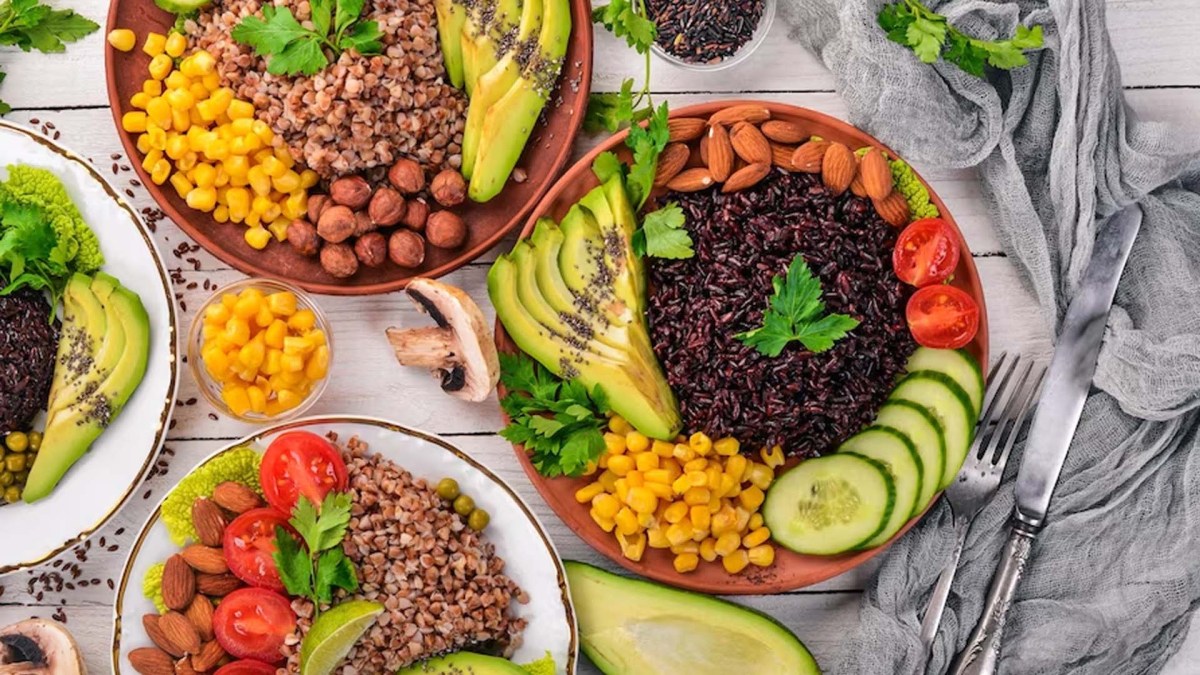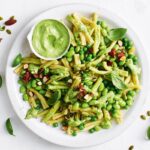Embark on a culinary journey into the vibrant world of plant-based eating! This exploration of vegan and vegetarian recipes unveils a treasure trove of delicious and nutritious meals, perfect for both seasoned cooks and kitchen novices. Imagine vibrant salads bursting with fresh herbs and colorful vegetables, hearty soups simmering with aromatic spices, and satisfying pasta dishes brimming with plant-based protein. We’ll guide you through simple yet elegant recipes, showcasing the versatility and flavor of a plant-based diet, transforming your meals into a celebration of fresh ingredients and culinary creativity.
From beginner-friendly recipes to more adventurous culinary creations, this guide offers a comprehensive look at the diverse landscape of vegan and vegetarian cuisine. We’ll delve into the art of crafting flavorful dishes, exploring various cooking techniques and offering practical tips for meal planning and minimizing food waste. Discover how to maximize the nutritional value of your meals while indulging in the rich textures and tastes that a plant-based lifestyle has to offer. Prepare to be inspired by the endless possibilities of a healthy and delicious plant-focused diet.
Popular Vegan & Vegetarian Recipe Categories
Embarking on a plant-based journey opens a world of culinary creativity. From hearty bowls to vibrant salads, the possibilities are endless. This section explores five popular recipe categories within vegan and vegetarian cooking, offering a glimpse into their diverse flavors and nutritional benefits. Each category showcases five delectable recipes, highlighting key ingredients and simple preparation methods.
Popular Vegan and Vegetarian Recipe Categories Overview
The following table organizes five of the most popular vegan and vegetarian recipe categories, providing a quick reference for exploring the diverse world of plant-based cuisine. These categories offer a balance of flavor, texture, and nutritional value, catering to various dietary needs and preferences.
| Category | Recipe 1 | Recipe 2 | Recipe 3 |
|---|---|---|---|
| Pasta Dishes | Creamy Tomato & Spinach Pasta (vegan): Pasta tossed in a vibrant tomato sauce, enriched with spinach and cashew cream for a rich, creamy texture. | Lentil Bolognese (vegan): Hearty lentil-based “meat” sauce simmered with tomatoes, herbs, and vegetables, served over your favorite pasta. | Lemon Garlic Pasta (vegetarian): Simple pasta tossed with lemon zest, garlic, olive oil, and fresh herbs for a bright and refreshing dish. |
| Salads | Mediterranean Quinoa Salad (vegan): Quinoa combined with chopped cucumbers, tomatoes, olives, red onion, and a lemon-herb vinaigrette. | Roasted Sweet Potato & Kale Salad (vegan): Roasted sweet potatoes and kale tossed with toasted pecans, cranberries, and a maple-mustard dressing. | Caprese Salad (vegetarian): Classic combination of fresh mozzarella, ripe tomatoes, and basil leaves, drizzled with balsamic glaze. |
| Soups | Creamy Vegan Potato Soup: Potatoes simmered in a creamy cashew-based broth, seasoned with herbs and spices. | Spicy Black Bean Soup (vegan): Black beans simmered in a flavorful broth with onions, peppers, and spices for a hearty and warming soup. | Lentil Soup (vegetarian): Lentils simmered with carrots, celery, onions, and vegetable broth for a nutritious and filling soup. |
| Stir-fries | Tofu & Broccoli Stir-fry (vegan): Firm tofu cubes stir-fried with broccoli florets, soy sauce, ginger, and garlic. | Peanut Noodles with Vegetables (vegan): Rice noodles tossed in a creamy peanut sauce with a variety of colorful vegetables. | Shrimp & Vegetable Stir-fry (vegetarian): Shrimp stir-fried with a medley of colorful vegetables and a light soy sauce-based marinade. |
| Curries | Vegan Chickpea Curry: Chickpeas simmered in a coconut milk-based curry sauce with onions, tomatoes, and aromatic spices. | Vegan Lentil Curry: Red lentils simmered in a flavorful curry sauce with spinach, coconut milk, and a blend of warming spices. | Vegetable Korma (vegetarian): A mild and creamy curry featuring a variety of vegetables simmered in a rich coconut milk sauce. |
Nutritional Benefits of Popular Vegan and Vegetarian Recipe Categories
Each recipe category offers a unique nutritional profile. Visualizing these benefits can enhance understanding of their impact on health and well-being.
Pasta Dishes: Imagine a vibrant plate of pasta, the deep red of the tomato sauce contrasting with the bright green of spinach. This represents the rich source of lycopene (antioxidant) from tomatoes and vitamin A from spinach. The creamy texture hints at the healthy fats and protein from the cashew cream.
Salads: Picture a colorful bowl overflowing with fresh vegetables and vibrant dressings. This visual represents the abundance of vitamins, minerals, and fiber from the various ingredients. The bright colors suggest a wealth of antioxidants, while the variety ensures a balanced intake of essential nutrients.
Soups: Envision a steaming bowl of soup, its aroma filling the air. This visual represents the warmth and comfort provided by these dishes. The hearty vegetables and legumes signify a high fiber and protein content, promoting satiety and digestive health.
Stir-fries: Imagine a sizzling pan filled with colorful vegetables and protein, creating a visually appealing and balanced meal. This showcases the abundance of vitamins, minerals, and antioxidants from the vegetables, along with the protein provided by tofu or shrimp.
Curries: Picture a fragrant bowl of curry, its rich sauce coating the vegetables and legumes. This visual represents the abundance of flavor and nutrients, including vitamins, minerals, and fiber. The spices add an extra layer of health benefits, offering anti-inflammatory properties.
Step-by-Step Recipe Creation

Crafting a delicious and satisfying vegan chili is easier than you might think. This recipe provides a hearty, flavorful base that you can easily customize to your preferences. The step-by-step instructions ensure a smooth cooking process, even for novice cooks. We’ll also explore ingredient substitutions and ways to adjust the spice level, making this recipe incredibly versatile.
Vegan Chili Recipe
This recipe yields approximately 6 servings of a rich and flavorful vegan chili. The cooking time, excluding prep, is approximately 45 minutes. The vibrant colors and textures of this chili will be a visual delight, appealing to both the eyes and the palate. Imagine the deep red of the tomatoes contrasting with the earthy browns of the beans and spices, creating a visually stunning dish.
- Preparation (15 minutes): Begin by finely chopping one large onion and two cloves of garlic. Dice one red bell pepper and one green bell pepper into roughly one-inch pieces. These vibrant colors will add visual appeal to your final chili. Open and drain two (15-ounce) cans of kidney beans and one (15-ounce) can of black beans. Imagine the glossy texture of the beans, ready to absorb the rich flavors of the chili. Finally, measure out two tablespoons of chili powder, one tablespoon of cumin, one teaspoon of smoked paprika, and half a teaspoon of cayenne pepper (adjust to taste). The earthy tones of the spices will create a fragrant aroma during cooking.
- Sautéing Vegetables (5 minutes): Heat two tablespoons of olive oil in a large pot or Dutch oven over medium heat. Add the chopped onion and sauté until softened, approximately 3-5 minutes. The onions will transform from opaque white to a translucent golden color. Next, add the garlic and bell peppers, and continue to sauté for another 3-5 minutes, until slightly softened. The peppers will release their sweet juices, creating a fragrant base for the chili.
- Building Flavor (5 minutes): Add the chili powder, cumin, smoked paprika, and cayenne pepper to the pot. Stir constantly for about 1 minute, allowing the spices to toast slightly and release their aromas. This step enhances the depth of flavor in your chili. The spices will deepen in color, creating a rich and aromatic base for the chili.
- Simmering the Chili (20 minutes): Add one (28-ounce) can of crushed tomatoes, one (15-ounce) can of diced tomatoes (undrained), and 4 cups of vegetable broth to the pot. Stir well to combine all ingredients. Bring the mixture to a simmer, then reduce heat to low, cover, and cook for at least 20 minutes, stirring occasionally. The chili will thicken and deepen in flavor as it simmers. The colors will blend, creating a visually appealing and rich consistency.
- Adding Beans and Finishing (10 minutes): Stir in the kidney beans and black beans. Continue to simmer for another 10 minutes, allowing the flavors to meld. Taste and adjust seasoning as needed. You can add more cayenne pepper for extra heat, or a pinch of salt and black pepper to enhance the overall flavor profile. The chili will be ready when the flavors have fully developed, and the beans are heated through. The final product will be a hearty and flavorful vegan chili, perfect for a comforting meal.
Ingredient Substitutions
Numerous substitutions can be made to cater to different dietary needs and preferences. For instance, other beans like pinto beans or chickpeas can replace kidney or black beans. Coconut milk can be added for a creamier texture, while vegetable broth can be swapped for water for a lighter consistency. If you are allergic to bell peppers, you can omit them or substitute them with other vegetables like zucchini or carrots. The visual appeal might change slightly, but the flavor profile will remain delightful.
Adjusting Spiciness
The spiciness of this chili is easily adjustable. For a milder chili, reduce or omit the cayenne pepper. For a spicier chili, increase the amount of cayenne pepper or add a few dashes of your favorite hot sauce. Consider adding a pinch of chipotle powder for a smoky heat, or some finely chopped jalapeños for a fresh, vibrant heat. The level of spiciness can be tailored to personal preference, ensuring everyone can enjoy this versatile dish.
Vegan & Vegetarian Meal Planning for a Week
Planning a week’s worth of delicious and nutritious vegan and vegetarian meals can seem daunting, but with a little organization and forethought, it becomes a manageable and rewarding process. This plan emphasizes variety, minimizing food waste, and providing a balanced intake of macronutrients. The calorie counts and macronutrient breakdowns are estimates and may vary depending on specific ingredients and portion sizes.
Sample Weekly Vegan & Vegetarian Meal Plan
A well-planned week of meals ensures a balanced diet and reduces the likelihood of impulsive unhealthy food choices. This sample plan offers a variety of flavors and textures, showcasing the versatility of plant-based cuisine. Remember to adjust portion sizes to meet your individual caloric needs.
| Day | Breakfast | Lunch | Dinner | Approximate Calories | Macronutrient Breakdown (approx.) |
|---|---|---|---|---|---|
| Monday | Overnight Oats with Berries and Nuts (350 calories): Creamy oats soaked in almond milk, topped with a vibrant mix of fresh blueberries, raspberries, and chopped almonds. | Lentil Soup with Whole-Wheat Bread (400 calories): Hearty lentil soup, bursting with flavor from carrots, celery, and onions, served with a slice of wholesome whole-wheat bread. | Black Bean Burgers on Whole-Wheat Buns with Sweet Potato Fries (600 calories): Juicy black bean burgers, seasoned with cumin and chili powder, nestled in whole-wheat buns and accompanied by crispy sweet potato fries. | 1350 | Protein: 40g, Carbohydrates: 200g, Fat: 40g |
| Tuesday | Tofu Scramble with Spinach and Mushrooms (300 calories): A flavorful scramble made with crumbled tofu, sautéed spinach, and earthy mushrooms, seasoned with turmeric and nutritional yeast for a cheesy flavor. | Quinoa Salad with Roasted Vegetables (450 calories): Fluffy quinoa tossed with roasted bell peppers, zucchini, and red onion, drizzled with a lemon-tahini dressing. | Vegan Chili with Cornbread (550 calories): A rich and savory chili packed with kidney beans, black beans, tomatoes, and corn, served with a slice of homemade cornbread. | 1300 | Protein: 35g, Carbohydrates: 180g, Fat: 45g |
| Wednesday | Smoothie with Banana, Spinach, and Almond Milk (250 calories): A vibrant green smoothie packed with nutrients, blended with frozen banana, spinach, almond milk, and a touch of honey or maple syrup. | Leftover Vegan Chili (550 calories) | Vegetable Stir-fry with Brown Rice (500 calories): A colorful stir-fry featuring broccoli, carrots, snap peas, and tofu, served over a bed of fluffy brown rice. | 1300 | Protein: 30g, Carbohydrates: 190g, Fat: 40g |
| Thursday | Peanut Butter Toast with Banana (300 calories): Two slices of whole-wheat toast topped with creamy peanut butter and sliced banana. | Salad with Chickpeas and Avocado (400 calories): A refreshing salad featuring mixed greens, chickpeas, avocado, and a light vinaigrette. | Vegetarian Pasta Primavera (600 calories): Pasta tossed with a medley of fresh seasonal vegetables like asparagus, peas, and zucchini, in a light lemon-garlic sauce. | 1300 | Protein: 35g, Carbohydrates: 190g, Fat: 45g |
| Friday | Breakfast Burrito with Tofu Scramble and Black Beans (400 calories): A hearty breakfast burrito filled with tofu scramble, black beans, salsa, and avocado. | Leftover Vegetarian Pasta Primavera (600 calories) | Lentil Shepherd’s Pie with Sweet Potato Topping (650 calories): A comforting and hearty shepherd’s pie with a lentil base and a creamy sweet potato topping. | 1650 | Protein: 45g, Carbohydrates: 220g, Fat: 50g |
| Saturday | Pancakes with Berries and Maple Syrup (450 calories): Fluffy vegan pancakes made with plant-based milk and topped with fresh berries and maple syrup. | Buddha Bowl with Roasted Sweet Potatoes and Chickpeas (500 calories): A colorful and nutritious buddha bowl with roasted sweet potatoes, chickpeas, quinoa, and a tahini dressing. | Pizza with Vegan Cheese and Vegetables (700 calories): Homemade pizza with a whole-wheat crust, vegan cheese, and your favorite vegetables. | 1650 | Protein: 40g, Carbohydrates: 230g, Fat: 55g |
| Sunday | Vegan Waffles with Fruit (400 calories): Crispy vegan waffles served with fresh fruit and a dollop of vegan whipped cream. | Leftover Pizza (700 calories) | Vegetable Curry with Brown Rice (550 calories): A fragrant and flavorful vegetable curry with coconut milk, served with brown rice. | 1650 | Protein: 40g, Carbohydrates: 210g, Fat: 50g |
Tips for Efficient Meal Preparation and Minimizing Food Waste
Efficient meal preparation is key to sticking to a healthy eating plan and reducing food waste. Strategic planning and smart storage techniques can make a significant difference.
Planning ahead, such as prepping ingredients on the weekend, saves valuable time during the week. Using leftovers creatively, for instance, turning leftover roasted vegetables into a frittata or using leftover rice in a stir-fry, prevents waste. Proper food storage, including using airtight containers and storing perishables appropriately, extends their shelf life. Composting food scraps is an environmentally friendly way to manage waste. Finally, accurate portioning helps prevent overbuying and minimizes leftovers.
As you conclude this culinary adventure, we hope you’re brimming with inspiration and ready to embrace the exciting world of vegan and vegetarian cooking. Remember, transitioning to a plant-based diet is a journey of discovery, filled with delicious surprises and endless opportunities for creativity in the kitchen. With a little practice and the right recipes, you can transform everyday meals into nourishing and flavorful experiences. So, gather your ingredients, embrace the vibrant colors and flavors of plant-based cuisine, and savor the journey towards a healthier, more sustainable lifestyle.
FAQ Overview
What are the main differences between vegan and vegetarian diets?
Vegetarian diets exclude meat, poultry, and seafood. Vegan diets are stricter, excluding all animal products, including dairy, eggs, and honey.
Are vegan and vegetarian diets suitable for athletes?
Yes, with careful planning, vegan and vegetarian diets can provide ample protein and nutrients to support athletic performance. Focus on incorporating a variety of protein sources and ensuring adequate calorie intake.
How can I ensure I’m getting enough protein on a plant-based diet?
Excellent plant-based protein sources include legumes (beans, lentils), tofu, tempeh, quinoa, nuts, seeds, and edamame. Combining different protein sources throughout the day helps maximize protein absorption.
What are some common challenges of transitioning to a plant-based diet?
Common challenges include finding suitable protein sources, ensuring adequate vitamin B12 intake (supplementation may be necessary), and navigating social situations where plant-based options are limited. Careful planning and preparation can mitigate these challenges.


